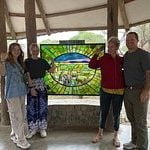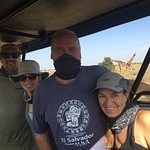Overview
The Umbwe Route is one of the lesser-known paths to climb Mount Kilimanjaro. It is well-known for its steep ascent and demands a high level of physical fitness and mental determination from climbers. The route is often chosen by experienced trekkers seeking a challenging and less-crowded journey to the summit.

History and Significance
The history of the Umbwe Route dates back to the early 20th century when it was initially used by local hunters and traders to access the slopes of Kilimanjaro. Over the years, it gained popularity as a trekking trail due to its captivating scenery and rugged appeal.
Umbwe Route vs. Other Kilimanjaro Routes
Compared to other popular routes like Marangu or Machame, the Umbwe Route is significantly steeper and demands greater physical endurance. It offers a more direct ascent to the summit, making it the shortest route in terms of distance, but it also means less time for acclimatization.
Scenic Beauty and Biodiversity
The Umbwe Route is not only about the challenge but also about the stunning beauty of the surrounding landscapes.
- Unique Flora and Fauna – The route traverses through diverse ecological zones, housing unique plant species and wildlife, including colobus monkeys and various bird species.
- The Lava Tower – The Lava Tower is a magnificent rock formation that serves as a prominent landmark along the trail, offering panoramic vistas.
- The Southern Glaciers – Climbers are treated to mesmerizing views of Kilimanjaro’s southern glaciers, although they have been gradually receding due to climate change.
Challenges and Safety Considerations
The Umbwe Route presents several challenges and potential risks that climbers should be aware of.
- Steepness and Altitude – The steepness of the route can be physically demanding, and the rapid ascent may lead to altitude-related symptoms.
- Weather Conditions – Weather conditions on Kilimanjaro can be unpredictable, and climbers must be prepared to face rain, snow, and extreme cold.
- Emergency Evacuation – In case of emergencies, having a well-prepared evacuation plan is crucial for the safety of all climbers.
Preparing for the Climb
For a successful and enjoyable journey along the Umbwe Route, adequate planning is essential before leaving.
- Fitness and Training – Climbers must engage in regular cardiovascular and strength training exercises to build stamina and endurance for the demanding trek.
- Gear and Equipment – Proper gear, including clothing, sleeping bags, trekking poles, and sturdy hiking boots, is essential to withstand the varying climatic conditions and rugged terrain.
- Acclimatization – Due to the rapid ascent of the Umbwe Route, acclimatization becomes even more critical. Climbers are advised to spend a few extra days at higher altitudes before starting the trek.
6 DAY UMBWE ITINERARY
DAY 1 – Umbwe Gate to Umbwe Camp
The day starts with a 50-minute drive to the Machame Gate, where registration procedures are finished. After that, we continue on to Umbwe Gate via villages, coffee, and banana plantations. On a forestry track that winds through the dense rain forest, the trail abruptly ascends. As we ascend the ridge between two rivers surrounded by enormous trees, the path becomes more congested and steeper. In the midst of dense vegetation and trees, Umbwe Camp is situated.
Elevation: 5,249 ft to 9,514 ft
Hiking Time: 5-7 hours
Distance: 11 km | 7 miles
Habitat: Health
DAY 2 – Umbwe Camp to Barranco Camp
On the second day of the trek, there are more rocky areas, less undergrowth, and ramshackle, moss-covered trees. Kilimanjaro can be seen in the distance as we rise in altitude. As we get closer to Barranco Valley, the path flattens. The Senecio Forest, which is strange but lovely, is traversed on the way from Umbwe Ridge to Barranco Camp.
Elevation: 9,514 ft to 13,044 ft
Hiking Time: 4-5 hours
Distance: 6 km | 4 miles
Habitat: Health
DAY 3 – Barranco Camp to Karanga Camp
We start the day by making our way down a ravine to the Great Barranco Wall’s base. Then we ascend the nearly 900-foot cliff, which is not technically difficult. We travel through a number of hills and valleys after leaving the top of the Barranco Wall before making a sharp turn into the Karanga Valley. We have one more steep ascent before we reach Karanga Camp. Acclimatization is the goal of today’s shorter day.
Elevation: 13,044 ft to 13,106 ft
Hiking Time: 4-5 hours
Distance: 5 km | 3 miles
Habitat: Alpine Desert
DAY 5 – Barafu Camp to Uhuru Peak to Mweka Camp
We start the ascent very early in the morning (around midnight). The hardest part of the trek both physically and mentally is this section. At this altitude and time of day, the wind and cold can be very strong. We climb in the dark for several hours, stopping frequently but only briefly. You will be rewarded with the most breathtaking sunrise you are ever likely to see approaching Mawenzi Peak close to Stella Point (18,900 feet). Finally, we reach Uhuru Peak, which is both Mount Kilimanjaro’s and Africa’s highest point.
We now begin our descent from the summit, going straight down to the Mweka Hut campsite while stopping at Barafu for lunch. Trekking poles are helpful because the trail is very rocky and can be quite taxing on the knees. Due to its location in the upper forest, Mweka Camp may experience late-afternoon mist or rain. We have our final meal on the mountain later in the evening before a well-earned rest.
Barafu Camp to Uhuru Peak
Elevation: 15,331 ft to 19,341 ft
Hiking Time: 7-8 hours
Distance: 5 km | 3 miles
Habitat: Arctic
Uhuru Peak to Mweka Camp
Elevation: 19,341 ft to 10,065 ft
Hiking Time: 4-6 hours
Distance: 12 km | 7 miles
Habitat: Rain Forest
DAY 6 – Mweka Camp to Mweka Gate
We continue the descent to Mweka Gate on our final day, where we pick up the summit certificates. It might be muddy and wet at lower altitudes. We travel another hour to Mweka Village from the gate. We’ll be picked up by a car at Mweka Village and taken back to our Moshi hotel.
Elevation: 10,065 ft to 5,380 ft
Hiking Time: 3-4 hours
Distance: 10 km | 6 miles
Habitat: Rain Forest






